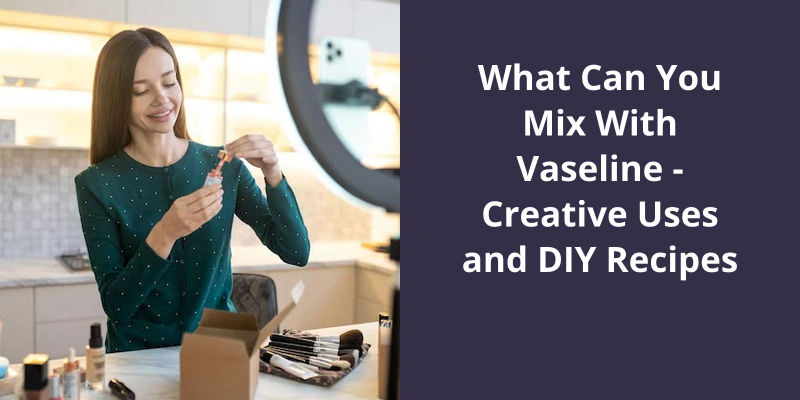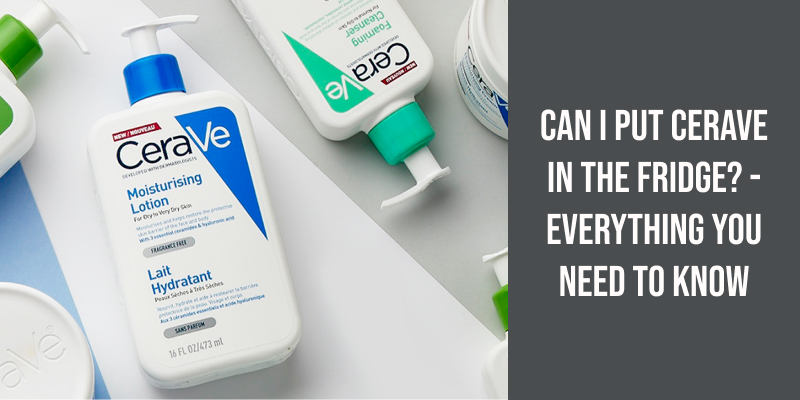You can mix Vaseline with a variety of things for different purposes. For instance, if you want to make a lip scrub, you can mix it with sugar. Mixing with a small bit of cool aid powder will give colored lip balm. To conjure lotion, combine Vaseline with coconut oil or baby lotion. It can also be mixed with sea salt to make a body scrub. For a homemade mascara, you can blend it with activated charcoal. Mixing it with cocoa or shea butter can help improve your skin’s appearance, and if you’re looking to remove marks and minor scratches from CDs, DVDs or BDs, mix Vaseline with toothpaste.

Is It OK to Mix Coconut Oil and Vaseline?
Coconut oil and Vaseline, two of the most popular skincare products out there, are often used separately in many different ways to achieve desired skin and hair goals. Now, many people are wondering if they can mix these two products together for an even more nourishing and moisturizing effect.
This combination can be especially helpful during the colder months when dry skin is a common issue.
These products can also be mixed together to create a hair mask to nourish and hydrate dry hair. By mixing equal parts of the two and applying it to the hair for a few hours or overnight, you can achieve soft and shiny hair that’s nourished from root to tip.
It’s safe, easy, and affordable. Whether you use them separately or mix them together, these two products can work wonders for your skin and hair, leaving you with a healthy and radiant glow all year round.
Benefits of Vaseline for Skin and Hair
Vaseline is beneficial for skin and hair as it provides hydration, helps to prevent dryness, and protects from environmental factors. When applied to skin, it can improve the skin’s texture and elasticity and can also be used to soothe minor cuts or burns. In hair, Vaseline can help to tame frizz and split ends, as well as providing a protective barrier against heat damage from styling tools.
If you’re looking for a simple yet effective DIY lip gloss recipe, this easy minty lip gloss might be just what you need. With the combination of peppermint oil and Vaseline, you’ll have a refreshing and moisturizing lip gloss that will leave your lips feeling smooth and revitalized. Plus, you can easily customize the amount you make, so you don’t have to worry about any waste. But before you dive into making this lip gloss, you might be wondering – can I mix Vaseline with peppermint oil? Let’s explore that question.
Can I Mix Vaseline With Peppermint Oil?
Peppermint oil and Vaseline could be mixed to create an easy and natural lip gloss with a cooling effect. Peppermint oil is a popular ingredient in beauty products because of it’s fresh scent and invigorating properties.
When mixing peppermint oil and Vaseline, it’s essential to use high-quality ingredients to ensure they’re safe for your skin. Only three drops of peppermint oil are needed per one tablespoon of Vaseline to make the lip gloss. It’s up to you to decide how much gloss you want to make, as the recipe is easy to scale up or down.
Peppermint oil has a natural tingling sensation when applied to the skin, making it ideal for lip gloss. It can cause a temporary plumping effect on the lips, leaving them looking fuller without any invasive procedures. Additionally, peppermint oil has anti-inflammatory properties that can alleviate dry and chapped lips.
Many store-bought lip products contain harmful ingredients like synthetic fragrances, parabens, and phthalates that can cause skin irritation and other health problems. With the DIY recipe, you can customize the lip gloss to your liking and avoid harmful chemicals.
The recipe is easy to follow, and you can make as much or as little as you need.
What Are Some Alternative Uses for Peppermint Oil in Skincare?
Peppermint oil can be used as a natural fragrance in skincare products, as well as a cooling and refreshing agent. It also has anti-inflammatory and antimicrobial properties that can help soothe and heal skin irritation and acne. However, it should be used in small concentrations and with caution, as it can be irritating to some people’s skin.
Source: Can you mix essential oil and Vaseline?
Now that we understand the benefits of Vaseline as a moisturizer, many people wonder if it can be mixed with other creams.
Can Vaseline Be Mixed With Other Creams?
One common question that many people may have about Vaseline is whether it can be mixed with other creams. However, it’s important to be cautious about the types of products that are mixed together, as certain combinations can have unintended consequences.
Firstly, it’s worth noting that Vaseline is a very versatile product that can be used in a variety of ways. Some people use it as a standalone moisturizer, while others mix it with other creams for added benefits. This can be especially helpful for people with dry or sensitive skin.
Firstly, it’s important to choose products that are compatible with each other. For example, mixing Vaseline with a lotion or cream that contains water may dilute the product and reduce it’s effectiveness. On the other hand, mixing Vaseline with an oil-based cream may result in a more powerful moisturizer that can penetrate deeper into the skin.
Another consideration is the amount of product that should be mixed together. It’s generally recommended to start with a small amount of product and gradually increase the amount as needed. This can help to avoid any potential irritation or adverse reactions.
One way to keep your hands and nails looking and feeling healthy during the colder months is to use a special serum. Vaseline®’s Intensive Care™ Healing Serum, for example, is an affordable option that can be purchased at many retailers nationwide. However, you can take this serum to the next level by adding a few drops of lavender essential oil to it. In this way, you can nourish your skin and create a “Glow on a Budget” item that will keep your hands and nails moisturized and healthy.
Can You Mix Lavender Essential Oil With Vaseline?
Lavender essential oil is one of the most popular and versatile essential oils out there, known for it’s calming and soothing properties. It’s used widely in aromatherapy and can help reduce stress, improve sleep, and alleviate anxiety. Vaseline, on the other hand, is a petroleum-based product that’s used for skincare purposes, particularly in moisturizing dry, cracked skin. The question is, can you mix lavender essential oil with Vaseline, and if so, what’re the benefits?
Lavender oil is known for it’s anti-inflammatory and antiseptic properties, which can help reduce redness, itchiness, and inflammation.
Using lavender essential oil with Vaseline can also help improve the appearance of dry, cracked nails. When combined, these two ingredients can create a powerful nail treatment that can help enhance the appearance of dry, cracked nails.
It’s important to use high-quality, pure essential oil and to mix the two ingredients in the right proportions.
When it comes to using carrier oils with essential oils, it’s important to choose a natural product that won’t interfere with the therapeutic properties of the oils. While Vaseline may seem like a convenient option, it isn’t recommended as a carrier oil due to it’s petroleum-based composition. Instead, there are numerous natural carrier oils available, each with their own unique benefits and properties. In this article, we’ll explore some of the best carrier oils to use with essential oils and how they can enhance the benefits of your aromatherapy practice.
Can You Use Vaseline as a Carrier for Essential Oils?
When it comes to using essential oils, it’s important to have a carrier oil to help dilute and spread the oil onto the desired surface. While there are many carrier oils available, using Vaseline isn’t recommended. Vaseline is a petroleum-based product, meaning it’s derived from fossil fuels. It isn’t a natural product, nor is it recommended for use with essential oils.
Essential oils are highly concentrated and may cause skin irritation if not properly diluted. Petroleum-based products, such as Vaseline, don’t mix well with essential oils and may actually cause the oil to clump together on the skin. This can lead to uneven distribution and, in some cases, skin irritation.
These products aren’t natural and shouldn’t be used on the skin. They can clog pores and prevent the skin from breathing properly. This can lead to a range of issues including acne, dryness, and even allergic reactions.
Some popular options include coconut oil, jojoba oil, and olive oil. These natural oils are better suited for use on the skin and can help to moisturize and nourish the skin while allowing the essential oil to penetrate more easily. They also have a longer shelf life than petroleum-based products, meaning they can be stored for longer periods without going bad.
Petroleum-based products aren’t natural and can cause skin irritation and other issues.
Natural Alternatives to Vaseline as a Carrier Oil for Essential Oils, Such as Sweet Almond Oil or Grapeseed Oil.
- Sweet almond oil
- Grapeseed oil
- Jojoba oil
- Coconut oil
- Olive oil
- Argan oil
- Sunflower oil
- Safflower oil
- Avocado oil
When it comes to skincare, using everyday household products can be tempting. However, some items may not be suitable for daily use, while others may result in unwanted side effects. One such product is Vaseline, a petroleum jelly-based product that’s commonly used to moisturize the skin. While it’s generally safe to use, it may cause skin irritation and acne in certain individuals. Let’s take a closer look at the pros and cons of using Vaseline on your face every day.
Is It OK to Put Vaseline on Your Face Everyday?
Many people use Vaseline as a moisturizer for their face, as it’s a common household product that’s been around for over a century. While it can be safe for most people to apply on their face, it’s important to keep in mind that everyones skin is different.
This can be especially helpful for those with dry skin or during the cold winter months when the air is drier. It provides a protective barrier that helps to prevent water loss, keeping your skin hydrated and healthy.
It’s always best to start with a clean face, then apply a moisturizer with ingredients that specifically target your skins individual needs. If you’re unsure about which products are best for your skin, consult with a dermatologist.
However, it may not be suitable for everyone, and it isn’t a replacement for a proper skincare routine. Always be aware of your skins individual needs and consult with a skincare professional if needed.
Conclusion
In conclusion, Vaseline proves to be a versatile and effective ingredient in DIY scrubs. By adding in a physical exfoliator of your choice, you can create a personalized scrub that’s gentle yet effective in removing dead skin cells. The moisturizing properties of Vaseline ensures that your skin stays hydrated and soft after exfoliation.





